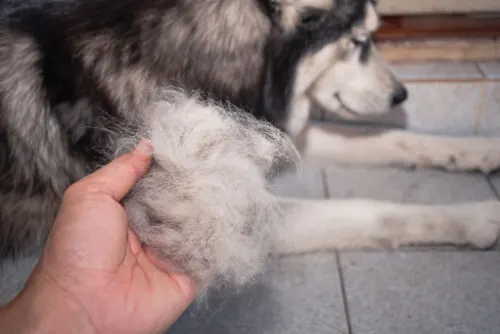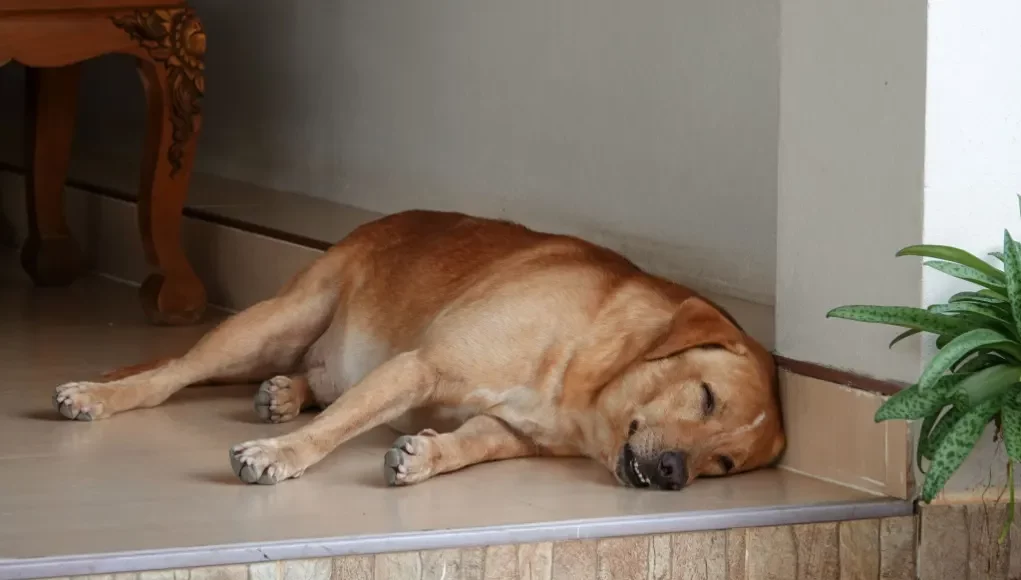Table of Contents
Is your dog becoming sluggish?
Many people attribute behavioral changes and inactivity to old age.
But what if we told you that there might be an underlying health condition causing these symptoms?
Hypothyroidism in dogs can be a condition that is scary when you don't understand what's going on.
This article will discuss the causes, symptoms, and treatment for hypothyroidism.
As dogs get older, especially purebred dogs, they are prone to developing certain health conditions.
Many dog owners often overlook behavioral changes, but this can lead to underlying conditions becoming worse.
Hypothyroidism often goes undiagnosed and untreated.
This is because the symptoms are subtle as compared to other health conditions.
You must stay vigilant and stop taking things for granted.
If you are concerned about anything, it's best to get it checked out by a professional.
What Is Hypothyroidism in Dogs?
According to a report by Ferguson, “Hypothyroidism is the most common hormonal problem in dogs.”
But what does this mean for dog owners?
In simpler terms, hypothyroidism is a condition that affects the thyroid, causing the hormone-making glands to slow down.
That could mean a slow metabolic rate, resulting in weight gain and lethargic behavior.
The thyroid gland is located in the neck and produces many hormones which affect the body.
Hypothyroidism is a very treatable condition.
We're here to help you understand the symptoms and treatment to ensure a fast recovery for your dog.
Maybe you are a concerned pet owner worried about the recent diagnosis.
Or perhaps you're just an animal enthusiast wanting to learn more.
Welcome! Let's head straight into the world of dog health.
Because with proper nourishment and nursing, anything is paw-sible!
Breeds Affected the Most by Hypothyroidism
Hypothyroidism is found in dogs of all ages and breeds.
However, while every dog may suffer from hypothyroidism, certain breeds are more likely to develop this condition. These include:
Hypothyroidism affects dogs of all ages but is most common in dogs 4 to 10 years old.
According to research, spaying may also increase the risks of developing hypothyroidism over time.
Neutered males and spayed females are at a higher risk of hypothyroidism.
Thus, weighing the pros and cons before neutering or spaying your pet is essential.
While it is known to improve their health, it can also increase their susceptibility to specific health conditions.
Moreover, hypothyroidism is most common in medium and large-sized breeds.
So, you'll rarely hear about a small or a miniature breed being affected by it.
The general consensus is that the increased risk of hypothyroidism in purebred dogs of medium to large size is due to genetic factors.
Alternatively, certain breeds are also less prone to hypothyroidism. These include:
- Rottweiler
- Bernese Mountain Dog
- German Shepherd
- Tibetan Spaniel
- Staffordshire Bull Terrier

Causes of Hypothyroidism in Dogs
Thyroid-related problems are one of the most common issues concerning dogs.
We've also established that it happens due to the low production of hormones by the thyroid gland.
However, which hormones are the most affected?
Let's find out!
Two hormones are responsible for a dog's metabolism, growth and development.
In a healthy dog, Triiodothyronine (also known as T3) and Thyroxine (also known as T4) will be consistent production.
The pituitary gland is responsible for the stable regulation of these hormones.
However, in a dog with hypothyroidism, the thyroid will decrease the production of T3 and T4 significantly.
Now, why does this happen, you may ask? Well, it depends on the type of hypothyroidism we are talking about.
There are three types of hypothyroidism, each with its own factors.
Primary Hypothyroidism
While nutrition, genetics, and environment may be a factor, Primary Hypothyroidism is due to two reasons:
Lymphocytic Thyroiditis
This is an autoimmune disorder that occurs when the immune system perceives the thyroid gland to be abnormal.
This results in the white blood cells attacking the thyroid gland, stopping the production of hormones.
The reasons why this occurs are unknown and unclear.
However, it is generally considered hereditary and attributed to the dog's genetics.
Idiopathic Thyroid Gland Atrophy
This condition occurs when fat tissue starts growing around the thyroid gland.
Again, the reasons for this are unknown, but this plays a vital role in developing hypothyroidism.
Lymphocytic Thyroiditis and Idiopathic Thyroid Gland Atrophy account for 95 percent of hypothyroidism cases in dogs.
Secondary Hypothyroidism
Secondary hypothyroidism occurs when the pituitary gland produces low levels of Thyroxine (T4).
This can happen due to the following:
- Pituitary Neoplasia
- Pituitary Malformation
- Drug-Induced Hypothyroidism
Pituitary neoplasia is an abnormal growth in the pituitary gland.
These tumors can either lead to abnormally high or low hormone production levels.
Moreover, these can be benign or cancerous.
However, this is generally rare and only accounts for 5 percent of hypothyroidism cases in dogs.
Congenital Hypothyroidism
Congenital hypothyroidism is slightly different from primary and secondary hypothyroidism.
Primary and secondary hypothyroidism usually develops in adulthood.
However, congenital hypothyroidism affects puppies that are in their infancy.
This is perhaps the rarest type of hypothyroidism in dogs.
The pituitary gland in congenital (starting at birth) hypothyroidism is underdeveloped and remains that way throughout life.
Other Factors Linked With Hypothyroidism
There are numerous claims that hypothyroidism is caused by external factors as opposed to the internal ones discussed above.
While not much scientific data is available about this, anecdotal evidence points to the following factors:
- Dietary habits: some people blame the usage of raw food, whereas others claim that preserved and packaged dog food may be the cause.
- Chemicals and Toxins: Exposure to chemicals, such as pesticides, may be a factor as they cause thyroid disruption, resulting in hormone production imbalances.
- Over-vaccination: may be stressful for the immune system, resulting in autoimmune diseases.
We do not recommend refusing vaccinations as vets have more knowledge.
You can share your concerns with your vet, and they will be happy to answer all your questions.

Symptoms of Hypothyroidism in Dogs
As the early symptoms of hypothyroidism start to kick in, some people think that their dog is simply being lazy or getting old.
However, if that is not how your dog usually is, it's best to check the symptoms and get an early diagnosis.
If you suspect your dog of having hypothyroidism, here are some signs to look out for:
- Is your dog gaining weight without a marked increase in his diet?
- Thyroid-related conditions are directly related to metabolism and may slow it down.
- Is your dog exhausted more often? Or has less energy than before?
- This usually leads to physical inactivity and a decreased interest in playing games.
- Does your dog have excessive hair shedding?
- This may be a sign of alopecia found in 26 percent of hypothyroidism cases.
- Is your dog's hair becoming increasingly dry and brittle?
- Has your dog been getting frequent skin and ear infections?
- That could be a sign of a poor immune system. Around 21 percent of dogs with hypothyroidism may become weaker over time.
- Have you tried shaving or clipping to regrow your dog's hair? Did it help?
- Slow or lack of hair growth can also be a symptom.
- High cholesterol is also a symptom.
- Be sure to get regular health checkups for your pet.
- Have you tried checking your dog's heartbeat?
- Dogs with hypothyroidism have a slower heartbeat as compared to healthy dogs.
According to the American Veterinary Medical Association Journal, these were the typical clinical findings.
However, there are also less common signs that may appear if your dog has hypothyroidism.
These include:
- The nerves may not function well, leading to problems relating to coordination and dragging of feet while walking.
- Facial skin becomes too thick or saggy, creating the impression of a ‘sad' dog.
- Hypothyroidism may have decreased libido and cause infertility if your dog has not been spayed or neutered.
- Non-spayed females may have miscarriages.
- Your dog's eyes may become too dry.
- Aggressiveness, irritability, depression, and anxiety are also symptoms.
- Any behavioral changes.
Treatment for Hypothyroidism in Dogs
Hypothyroidism in dogs is not entirely curable.
If any symptoms arise and you think your dog has hypothyroidism, it is best to contact a vet for a diagnosis.
Hypothyroidism Diagnosis
Doctors can diagnose hypothyroidism much earlier now.
That is because of the recent advancements in medical science.
Vets run several blood tests to identify the type of hypothyroidism.
These measure the Thyroid Stimulating Hormone (TSH) levels. This is followed by checking the hormone thyroxine (T4) if the doctor deems it necessary.
These tests are not only necessary for the diagnosis but also for the potential treatment.
Various medicines, supplements, and vitamins are prescribed based on these tests.
Treatment
Hypothyroidism is treatable through medication.
Your vet will prescribe the appropriate medicine and dosage based on your dog's weight and the tests performed during the diagnosis process.
“But is it effective?” you might be wondering, “and how long does it take to work?”
Well, it's important to remember that hypothyroidism in dogs isn't operable, so any treatment, including medication, will be long-term.
Remember that treatment will significantly improve your dog's quality of life.
This medication will consist of synthetic thyroid hormones. These will help stabilize the hormonal imbalance.
Soon your dog will start getting more physically active.
However, hair regrowth and infections relating to the skin and ears may take longer to heal.
Your dog's dosage of hormones will vary as every dog has a different tolerance for thyroid replacement therapy.
You must get regular bloodwork so your vet can see if the treatment works and adjust the dosage accordingly.
In the case of an overdose, hyperthyroidism will occur.
This is when there are excess thyroid hormones resulting in a high metabolism, lack of sleep, weight loss, and increased thirst.
Thus, keeping the medication away from your pets and small children is essential.

Diet for Dogs with Hypothyroidism
Nutrition is vital for the well-being of any individual or animal.
It is vital for improving the health of dogs with hypothyroidism.
We have already discussed how artificial additives in packaged dog food might be an underlying cause of this condition.
Thus, we do not recommend feeding your dog overly processed foods.
You must incorporate more natural ingredients into your dog's diet and use fresh products.
Many researchers recommend:
- Fish
- Poultry
- Meat
- Salmon oil
These will also assist in the long-term recovery of your pet's hair loss.
We always recommend homemade dog food as it is nutritionally complex and does not contain any harmful preservatives.
Apart from the foods mentioned above, you can also check out our guide on the nutritional needs of dogs when making homemade dog food.
This will give you a deeper insight into what your dog needs.
Supplements are also recommended as they can improve thyroid function.
Include foods that are rich sources of vitamin A, vitamin B, and folic acid.
Check out the following youtube video to learn more about supplements for dogs with hypothyroidism:
Natural Remedies for Hypothyroidism in Dogs
Hypothyroidism in Dogs: Summary
There is no cure for hypothyroidism yet.
However, the condition is manageable through a change in dietary habits and supplementation.
A vet may recommend thyroid hormone replacement therapy with medication to stabilize your dog's health.
A hypothyroidism diagnosis is quite distressing. But we encourage you to stay calm and focus on what you can do to improve your dog's quality of life.
Giving your nutritious dog food and lots of attention is an excellent place to start.
Many dogs with hypothyroidism lead long and happy lives with proper treatment.
If your dog does not like taking medication, you can Insert it into a treat. Your dog will take it without a fuss.
Be mindful of any behavioral and physical changes.
Always take your dog for regular health checkups at the vet and ensure your dog gets lots of exercise.
In the comments below, let us know what helped your dog become more active.













